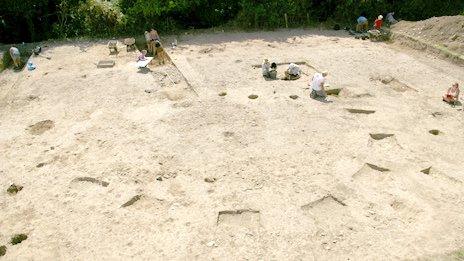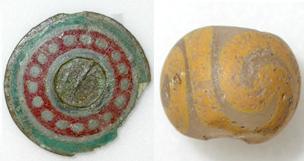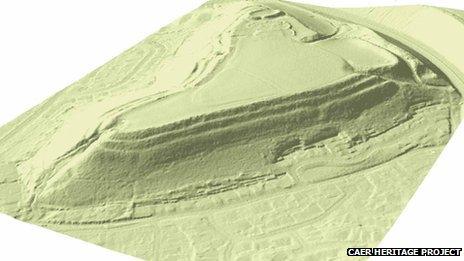Cardiff Iron Age hill fort 'was a centre of power'
- Published

The dig has so far found three Iron Age roundhouses and a stone-built pathway
Early results from an archaeological dig at an Iron Age fort in Cardiff suggest it may have been the region's centre of power, experts have said.
A team from Cardiff University has spent the last month excavating Caerau hill fort near Ely.
It is smaller than its contemporaries at Pentyrch and Pontprennau and had been thought to be inferior in status.
But structures and artefacts so far unearthed suggest the fort remained important well into the Roman era.
Until now it has been thought that the fort was purely a stronghold of the Silurian tribe who inhabited this part of Wales from around the 5th Century BC, falling into disuse once they were finally defeated by the Romans, circa 75 AD.

The enamelled disc brooch (left) is Roman era while the glass bead dates from the Iron Age
However the initial dig this summer has uncovered a considerable amount of new information, including three Iron Age roundhouses and a stone-built pathway that runs around the edge of the hill fort, suggesting to the experts a possible domestic and/or political dimension.
Also, the mix of Silurian and Roman artefacts may indicate that the fort was occupied much later than had been thought, and that the two groups might have mingled there.
Dr Oliver Davis, from the university's School of History, Archaeology and Religion, said: "People think of these sites as defensive structures, but our attention is turning to whether the people who lived there were actually developing a community or collective identity for themselves.
"Our community excavations show that occupation at the site continued until at least the third century AD, well into the Roman period.
"Domestic life is indicated by the discovery of simple tools and ceramics from all periods.
"A glimpse of the personality of the inhabitants is provided by the discovery of a glass bead of Iron Age date and an enamelled disc brooch of Roman date.
"Both these objects indicate that individuals were concerned with their appearance, and that life in the past was a little more colourful than we sometimes think.
"Over the past month the team has also examined the inner of the three ramparts that surround the hill fort. These ramparts and their associated ditches were unlikely to have been built just for defence."
But as well as colour from the past, Dave Horton, of the community organisation Action in Caerau and Ely, said the way local residents have had a hand in the discoveries has also lent a little colour to the present.
"The last few weeks have seen a whirlwind of activity in Ely and Caerau focused around our beautiful iron-age hill fort," he said.
"Literally hundreds of local people have visited the site and have dug together, learned new skills, shared local knowledge, and have celebrated together with a fantastic Iron Age hog roast."
"We have all walked down the hill to our homes with a different perspective. We have found new pride in the history of our community."

An impression of the Ely hillfort
- Published24 June 2013